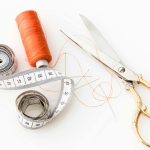Discover 11 incredible cotton fabric painting techniques that will bring your creativity to life!
Unveil the world of tie-dyeing, block printing, shibori, batik, stenciling, reverse painting, spray painting, embroidery painting, and sponging.
With these techniques, you can transform plain cotton fabric into works of art.
Learn how to add vibrant colors and intricate designs to your fabric projects.
Get ready to unleash your artistic side and create stunning masterpieces using these 11 amazing painting techniques.
Table of Contents
Tie-Dyeing
To begin tie-dyeing cotton fabric, gather your materials and prepare a clean workspace. Tie-dyeing is a fun and creative way to add vibrant colors and unique patterns to your cotton fabric. One of the key elements of tie-dyeing is the use of batik variations, which involve creating intricate designs by using wax or other materials to resist dye in certain areas. This technique allows for endless possibilities and allows you to create stunning and personalized designs.
When tie-dyeing, you can also experiment with natural dyeing techniques. Instead of using synthetic dyes, you can opt for natural substances like fruits, vegetables, and plants to create beautiful and eco-friendly colors. For example, you can use turmeric to achieve a warm yellow shade or try beetroot for a vibrant pink hue. Not only does this add an element of sustainability to your tie-dyeing process, but it also gives your fabric a unique and organic look.
Remember to soak your cotton fabric in water before tie-dyeing to ensure even absorption of the dye. Then, gather your desired colors and apply them to the fabric using various techniques like folding, twisting, or scrunching. Once the fabric is dyed, let it sit for a few hours to allow the colors to set. Finally, rinse the fabric until the water runs clear and let it dry.
Tie-dyeing is a versatile and enjoyable technique that allows you to unleash your creativity and create one-of-a-kind cotton fabric pieces. Experiment with different colors, patterns, and techniques to achieve stunning results.
Block Printing
Try block printing as a unique and creative way to add intricate designs to your cotton fabric. Block printing involves carving a design onto a block and then using fabric ink to transfer the design onto the fabric. This technique allows you to create repetitive patterns or motifs that can be customized to suit your own style.
To get started with block printing, you will need a few supplies. Firstly, you will need a carving block, which is usually made of linoleum or rubber. This block will serve as your canvas for carving your design. You will also need carving tools to create your design on the block. Once you have carved your design, you can then apply fabric ink to the block and press it onto the fabric to transfer the design.
Block printing allows for endless possibilities when it comes to creating unique patterns and designs on your cotton fabric. Whether you prefer bold geometric shapes or delicate floral motifs, block printing can help you achieve the desired look. So why not give block printing a try and unleash your creativity on your cotton fabric?
| Advantages | Disadvantages |
|---|---|
| Easy to learn and practice | Limited color options |
| Versatile, can be used on various fabrics | Time-consuming process |
| Allows for precise and intricate designs | Requires special carving tools |
| Customizable to suit your style | Requires practice to achieve desired results |
| Creates unique and handmade pieces | May require multiple layers for full coverage |
Shibori
Let’s talk about Shibori, a fascinating fabric painting technique that offers a variety of tie-dye variations.
Shibori involves the intricate process of indigo dyeing, which creates beautiful patterns and shades on cotton fabric.
Today, you’ll also discover contemporary Shibori designs that showcase the versatility and creativity of this ancient Japanese art form.
Tie-Dye Variations
Explore the various tie-dye variations, known as Shibori, to create stunning patterns on cotton fabric. Shibori offers a wide range of techniques that allow you to experiment with different tie-dye color combinations and fabric patterns, giving your creations a unique and captivating look. Let your creativity run wild as you dive into the world of Shibori and discover the endless possibilities it offers.
Here are some bullet points to get you inspired:
- Traditional Shibori techniques like Kanoko and Arashi create beautiful patterns resembling water ripples or stormy skies.
- Experiment with Itajime Shibori, which involves folding and clamping fabric to create geometric shapes and lines.
- Try Kumo Shibori, a technique that involves pleating, twisting, and binding fabric to achieve intricate spiderweb-like patterns.
- Explore the art of Nui Shibori, where fabric is stitched before dyeing, resulting in stunning textured designs.
With these Shibori techniques, you can elevate your tie-dye game and transform plain cotton fabric into wearable works of art. Unleash your creativity and enjoy the mesmerizing process of creating unique and stunning tie-dye patterns.
Indigo Dyeing Process
To continue exploring the world of Shibori, delve into the indigo dyeing process, a captivating technique that adds depth and richness to cotton fabric.
Indigo dyeing techniques have a long and fascinating history. Indigo, a natural blue dye extracted from the leaves of the indigofera tinctoria plant, has been used for centuries in many cultures around the world.
The process involves creating intricate patterns on fabric using various folding, twisting, and binding techniques. These patterns are then immersed in a vat of indigo dye, where the fabric absorbs the dye and takes on a beautiful blue color.
The indigo dyeing process is known for its unique ability to create a range of shades and patterns, making it a popular choice for creating stunning and unique cotton fabric designs.
Contemporary Shibori Designs
Discover the versatility of Contemporary Shibori Designs (Shibori) with a variety of innovative techniques.
Contemporary textile artists have taken the traditional Japanese art of fabric dyeing to new heights, creating modern and vibrant designs that push the boundaries of the craft. Using modern fabric dyeing methods, these artists are able to achieve stunning and intricate patterns on their textiles.
Here are four reasons why contemporary Shibori designs are worth exploring:
-
Expressive and Bold: Contemporary Shibori designs allow artists to express their creativity and make a bold statement with their fabric creations.
-
Unique and Individual: Each Shibori design is unique, showcasing the artist’s individual style and vision.
-
Textural and Dimensional: The folding, twisting, and binding techniques used in Shibori result in textiles with a beautiful texture and dimensional appearance.
-
Versatile and Adaptable: Contemporary Shibori designs can be applied to a wide range of fabrics and can be incorporated into various fashion and home decor projects.
Explore the world of contemporary Shibori designs and unleash your creativity in the realm of modern fabric dyeing.
Batik
Let’s talk about Batik, a technique that involves using wax to create a resist pattern on fabric before dyeing it.
This method is widely used in Indonesia and has a rich cultural history.
Wax Resist Technique
You can create unique and vibrant designs on cotton fabric using the wax resist technique, also known as Batik. This technique involves applying wax to the fabric to create patterns and then dyeing the fabric. The wax resists the dye, resulting in beautiful and intricate designs.
Here are some reasons why the wax resist technique is so captivating:
-
Versatility: The wax resist technique allows you to create a wide range of patterns and designs, from simple and elegant to bold and complex.
-
Uniqueness: Each wax resist application is unique, making your fabric truly one-of-a-kind.
-
Vibrancy: The combination of wax resist and vibrant dyes results in eye-catching and vivid colors.
-
Artistic expression: With the wax resist technique, you have the freedom to express your creativity and create personalized designs on your cotton fabric.
Explore the wax resist technique to unleash your creativity and add a touch of uniqueness to your fabric projects.
Dyeing Process Explained
To fully understand the wax resist technique, it’s important to delve into the dyeing process known as Batik.
Batik is a traditional dyeing method that involves fabric manipulation to create intricate designs. There are various dyeing techniques used in Batik, including immersion dyeing, hand painting, and stamping.
In immersion dyeing, the fabric is submerged in a dye bath to achieve an even color. Hand painting involves manually applying dye onto the fabric using brushes or other tools. Stamping, on the other hand, uses carved blocks or stamps to transfer the dye onto the fabric.
These techniques allow for unique patterns and designs to be created on the fabric, making Batik a versatile and artistic form of fabric dyeing.
Traditional Indonesian Art Form
The traditional Indonesian art form of Batik involves the intricate manipulation of fabric to create unique designs. Batik is a renowned traditional Indonesian art form that has been passed down through generations. It requires great skill and precision to create these stunning fabric paintings.
Here are some key features of Batik:
-
Rich Cultural Heritage: Batik is deeply rooted in Indonesian culture and has been practiced for centuries. It holds great significance and is often used for special occasions and ceremonies.
-
Intricate Patterns: Batik designs are known for their intricate patterns and motifs. Each design tells a story and reflects the artist’s creativity and imagination.
-
Wax Resist Technique: The fabric is first treated with wax, and then dyed multiple times to achieve the desired colors and patterns. The wax acts as a resist, preventing the dye from penetrating certain areas of the fabric.
-
Handcrafted Artistry: Batik is a labor-intensive process that requires meticulous attention to detail. Each piece is handcrafted, making it a true work of art.
Batik isn’t just a fabric painting technique; it’s a part of Indonesia’s cultural identity and a beautiful form of artistic expression.
Stenciling
One popular technique for painting on cotton fabric is using stencils. Stenciling allows you to create precise and intricate designs on your fabric with ease. By using pre-cut stencils or creating your own, you can achieve professional-looking results without the need for advanced painting skills.
To engage the audience and provide a visual aid, here is a table showcasing three different stenciling techniques:
| Technique | Description |
|---|---|
| Freehand | This technique involves painting directly onto the fabric using a stencil as a guide. You have complete control over the design and can add your own personal touch. |
| Spray Painting | This technique utilizes spray paint to create a quick and even application of color. It is ideal for creating large-scale designs or adding background elements. |
| Reverse Stencil | In this technique, the stencil is placed on the fabric and then paint is applied around it. Once the stencil is removed, the design remains, creating a negative image. |
Freehand Painting
Now it’s time to explore the art of freehand painting on cotton fabric.
With brushstroke techniques, you can create unique designs and patterns that reflect your artistic style.
Blending colors seamlessly will bring depth and dimension to your artwork, while adding intricate details will make your fabric painting truly stand out.
Let’s discover the endless possibilities of freehand painting on cotton fabric.
Brushstroke Techniques for Freehand Painting
Get started on your freehand painting with these essential brushstroke techniques. To bring your cotton fabric painting to life, it’s important to master blending techniques and texture creation. Here are some tips to help you achieve stunning results:
- Cross-hatching: Create depth and texture by layering brushstrokes in a crisscross pattern.
- Dabbing: Use a stippling technique to add texture and dimension to your artwork.
- Scumbling: Apply a thin layer of paint with quick, light brushstrokes to create a soft, airy effect.
- Dry brushing: Use a dry brush to add texture and highlight details by lightly dragging it across the fabric.
Blending Colors Seamlessly
Master the art of seamlessly blending colors in your freehand cotton fabric paintings. Blending techniques and color mixing are essential skills that will take your artwork to the next level.
To achieve a smooth transition between colors, start by selecting two or more shades that you want to blend together. Apply the lighter shade first and gradually add the darker shade, using a brush or your fingertips to gently blend the colors together.
Experiment with different strokes and pressures to create different effects. Remember to clean your brush in between color changes to avoid muddying the colors.
Practice and patience are key to mastering the art of seamless color blending in your fabric paintings.
Adding Intricate Details
To enhance your freehand cotton fabric paintings, incorporate intricate details that add depth and dimension to your artwork. These details not only make your paintings visually striking but also evoke a sense of emotion and creativity.
Consider adding intricate embroidery, which can bring a delicate and intricate touch to your design. You can also experiment with bead embellishment, using beads of different sizes and colors to create texture and sparkle.
Screen Printing
When screen printing on cotton fabric, you can achieve vibrant and detailed designs. Screen printing, also known as silk screening, is a popular textile printing technique that allows you to transfer ink onto fabric using a specially prepared screen. This technique is widely used in the fashion industry to create unique and eye-catching designs on cotton garments.
To start the screen printing process, a design is first created on a transparency or stencil. The screen, which is made of a fine mesh stretched over a frame, is then coated with a light-sensitive emulsion. The design is placed on top of the screen, and the emulsion is exposed to light. The areas of the screen that aren’t exposed to light are washed away, leaving behind a stencil of the design.
Next, ink is applied to the screen and pushed through the stencil using a squeegee. The ink passes through the open areas of the stencil and onto the fabric below, creating the desired design. This process can be repeated multiple times using different colors to achieve intricate and multi-colored designs.
Screen printing on cotton fabric offers several advantages. It allows for precise and detailed designs, as the stencil can be finely crafted. The ink used in screen printing is also highly pigmented, resulting in vibrant and long-lasting colors. Additionally, screen printing provides excellent coverage, ensuring that the design stands out on the cotton fabric.
Reverse Painting
Reverse painting is a technique that involves applying paint to the backside of a transparent surface, such as glass or plastic, to create a design that’s viewed from the opposite side. This unique fabric painting style offers endless possibilities for creativity and experimentation.
Here are some reverse painting techniques that you can explore:
-
Layering: By applying multiple layers of paint on the transparent surface, you can create depth and dimension in your design. This technique allows for the blending of colors and the creation of intricate patterns.
-
Negative Space: By leaving certain areas of the transparent surface unpainted, you can create interesting negative space effects in your design. This technique adds a touch of mystery and intrigue to your artwork.
-
Stencil Application: Using stencils, you can easily create precise and intricate designs on the transparent surface. This technique allows for the replication of complex patterns and shapes.
-
Mixed Media: Reverse painting can be combined with other art mediums, such as markers or colored pencils, to add texture and detail to your design. This technique adds versatility and depth to your artwork.
With these reverse painting techniques, you can create stunning and unique fabric paintings that will captivate and inspire. So, grab your transparent surface and let your creativity flow!
Spray Painting
Continuing the exploration of fabric painting techniques, let’s now delve into the world of spray painting.
Spray painting on fabric offers a unique way to create texture and add depth to your designs. By using different techniques and tools, you can achieve stunning effects that aren’t possible with other painting methods.
One popular technique is to use stencils with spray paint. This allows you to create intricate patterns and designs on your fabric. Simply place the stencil on the fabric and spray paint over it. The paint will seep through the openings of the stencil, creating a crisp and precise design.
Another technique is to create texture with spray paint. You can achieve this by using different materials as stencils, such as lace or mesh. Place the material on the fabric and spray paint over it. When you remove the material, you’ll be left with a textured pattern on your fabric.
Lastly, you can also experiment with layering spray paint. Start by spraying a base color on the fabric and let it dry. Then, use a different color and spray it over the base. This will create a layered effect and add depth to your design.
Embroidery Painting
To add even more dimension to your fabric painting, try incorporating embroidery painting into your technique. Embroidery painting combines the art of painting with the art of embroidery, creating a unique and textured look on your fabric.
Here are some embroidery techniques you can try:
-
Thread Painting: This technique involves using different colored threads to create detailed designs on your fabric. It allows you to add intricate patterns and textures to your paintings, giving them a more realistic and three-dimensional look.
-
Satin Stitch: This technique involves filling in areas of your painting with long, smooth stitches. It adds a smooth and shiny texture to your fabric, making your paintings look more vibrant and eye-catching.
-
French Knots: French knots are small, decorative knots that can be used to add texture and dimension to your fabric. They can be used to create small dots or add details to your painting, giving it a unique and whimsical look.
-
Couching: This technique involves stitching down a thicker thread or yarn onto your fabric to create raised areas or outlines in your painting. It adds depth and texture to your artwork, making it stand out even more.
Sponging
To achieve a unique texture and blend colors seamlessly in your fabric painting, sponging is an effective technique to employ. Sponging allows you to create beautiful patterns and variations on your cotton fabric. There are several sponging techniques to explore, each offering a different effect.
One popular sponging technique is the stippling method. This involves using a sponge to dab small dots of paint onto the fabric, creating a textured appearance. By varying the pressure and angle of the sponge, you can achieve different levels of intensity and depth in your design.
Another technique is the swirling method, where you use a sponge to create swirling patterns on the fabric. This gives a sense of movement and adds visual interest to your artwork. You can experiment with different colors and blend them together using the sponge to create a stunning effect.
Sponging can also be combined with other alternative painting methods, such as stenciling or stamping. By using a sponge to apply paint through a stencil or to stamp onto the fabric, you can create intricate designs and add extra detail to your artwork.
Frequently Asked Questions
Can Cotton Fabric Painting Techniques Be Used on Other Types of Fabric, Such as Silk or Polyester?
Yes, cotton fabric painting techniques can be adapted for silk and polyester. Experiment with different fabric paints and techniques to achieve desired results on these fabrics.
What Are Some Common Mistakes to Avoid When Practicing These Cotton Fabric Painting Techniques?
When practicing cotton fabric painting techniques, beginners often make common mistakes. To avoid these, remember to prepare the fabric properly, use the right tools, and practice with small projects first.
Are There Any Specific Fabric Paints or Dyes That Work Best for Cotton Fabric Painting?
When painting on cotton fabric, it’s important to choose the best fabric paints or dyes. Look for options specifically designed for cotton, as they will provide better color saturation and durability.
Can These Techniques Be Used on Colored or Patterned Cotton Fabric, or Do They Work Best on Plain White Fabric?
Yes, you can use these techniques on colored or patterned cotton fabric. To achieve vibrant colors on cotton, make sure to prep the fabric properly and use fabric paints or dyes designed for cotton.
How Long Do the Painted Designs Typically Last on Cotton Fabric, and Is There a Recommended Method for Washing and Caring for the Painted Fabric?
Typically, painted designs on cotton fabric can last a long time if properly cared for. To preserve the designs, it is recommended to wash the fabric gently by hand or on a delicate cycle.
- The Use of Nonwovens in Construction and Civil Engineering - July 11, 2025
- The Use of Nonwovens in Construction and Civil Engineering - July 11, 2025
- The Use of Nonwovens in Construction and Civil Engineering - July 11, 2025






